They All Wanted It - A Journey in Sicily (original) (raw)
 - Introduction
(left) Temple to Hercules at Agrigento; (right) detail of the apse of Palermo's Cathedral
- Introduction
(left) Temple to Hercules at Agrigento; (right) detail of the apse of Palermo's Cathedral
Naples, March 26, 1787. To-morrow this letter will leave for you. On Thursday, the 29th, I go to Palermo in the corvette. (..) The doubt whether I should go or remain made me unsettled even in the use of my stay here; now that I have made up my mind, things go on better. For my mental state this journey is salutary - indeed necessary. I see Sicily pointing to Africa, and to Asia, and to the wonderful, whither so many rays of the world's history are directed. Palermo, April 13, 1787. Italy without Sicily leaves no image on the soul: here is the key to all. J. W. Goethe - Italian Journey - Translation by Charles Nisbet

## 1864 Stielers Hand-Atlas - Map of Sicily. The numbers indicate the ruins of ancient towns or monuments: 1) Solunto; 2) Segesta; 3) Selinunte; 4) Villa del Casale; 5) Akrai; 6) Tindari. The black dots indicate towns covered in this section which may (e.g. Syracuse) or may not (e.g. Noto) retain ancient monuments. Girgenti is today's Agrigento and M. S. Giuliano is today's Erice. The red dots indicate active volcanoes.
The image used as background for this page shows the symbol of Sicily, the head of a Gorgon surrounded by three bent running legs, on an ancient dish at the Archaeological Museum of Agrigento. The island was known as Trinacria, with reference to the three capes at the North-East, South and West vertices of its triangular shape. From the Xth century until the early XIX century Sicily was divided into three administrative districts (valleys) each of which included one of the three capes: Val Demone with Capo del Faro (North-East), Val di Noto with Capo Passero (South) and Val di Mazara with Capo Boeo (West).

## Museo Archeologico Regionale di Siracusa: skeleton of a dwarf elephant
Sicily is separated from the coast of Tunisia by a ninety-mile-wide strait. It might have been passable for elephants during the Ice Age because the continental shelf between Sicily and Tunisia houses a number of submarine volcanoes which could have created ridges above the low sea level of that period. Skulls of dwarf elephants were perhaps found by the first Greek settlers; they might have led to the legend of the Cyclops, giants mentioned by Homer in the Odyssey. In particular the fact that the skulls had a large central opening could have originated the belief that the Cyclops (e.g. Polyphemus) had only one eye.
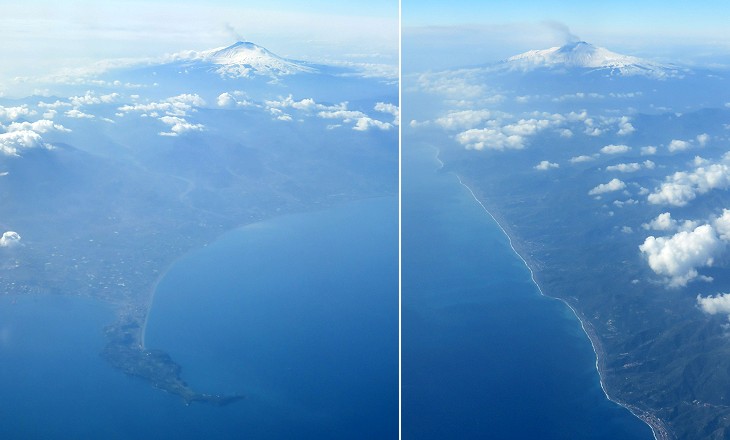
## Mt. Etna (3,300 m/10,900 ft) seen from a plane above the Tyrrhenian coast near Cape Milazzo (left) and above the Ionian one south of Messina (right)
## And that snowed pillar heavenly high, Etna, nurse of ceaseless frost; From whose caverned depths aspire, In purest folds upwreathing, tost, Fountains of approachless fire. By day, a flood of smouldering smoke, With sullen gleam the torrents pour; But in darkness, many a rock, Crimson flame, along the shore, Hurls to the deep with deafening roar.
Pindar - Pythian Ode I - Translation by Henry Francis Cary. Aeschylus and others say, because of the calamity that had befallen this region, (that) (..) Sicily was once torn apart from the continent by earthquakes. (..) They infer from the occurrences about Aetna and in other parts of Sicily, and in Lipara and in the islands about it (..) that it is not unreasonable to suppose that the separation actually took place. Now at the present time the earth about the Strait (of Messina), they say, is but seldom shaken by earthquakes, because the orifices there, through which the fire is blown up and the red-hot masses and the waters are ejected, are open. At that time, however, the fire that was smouldering beneath the earth, together with the wind, produced violent earthquakes, because the passages to the surface were all blocked up. Strabo - Geography - Book VI - Loeb Classical Library edition. Sicily is situated in a very critical location from a seismic point of view as it stands on the edges of the African and the Eurasian tectonic plates. Most of the island belongs to the African plate, but its north-eastern section is on the Eurasian one. In addition to Etna, Stromboli and Vulcano, submarine volcanoes have been identified in the Tyrrhenian Sea and in the sea between the island and Tunisia. Sicily repeatedly experienced devastating earthquakes, such as that which destroyed most of the towns in Val di Noto in 1693 and those which destroyed Messina in 1783 and 1908.
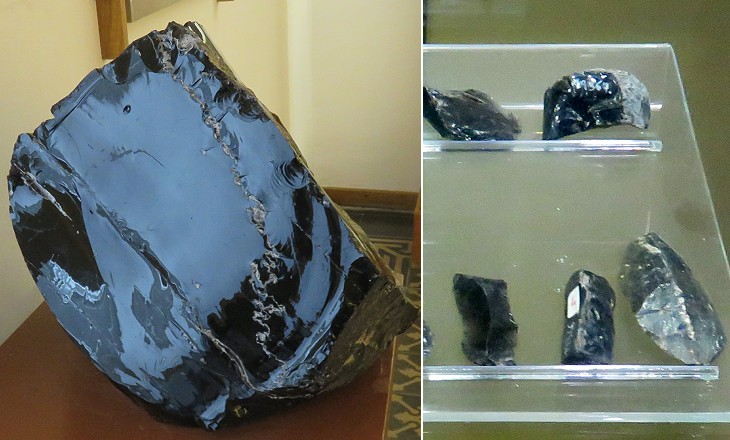
## (left) Archaeological Museum of Lipari: a block of obsidian, a volcanic glass; (right) Archaeological Museum of Milazzo: pieces of obsidian with sharp edges
The volcanic features of Sicily were not without some beneficial aspects for its first inhabitants. Volcanic ashes significantly increased the fertility of the soil and lava eruptions could lead to the creation of obsidian, a sort of hard glass, which fractured into pieces with sharp edges. Before the development of metallurgy these pieces were used as utensils and as heads for spears and arrows. The inhabitants of Lipari where obsidian was mined in ca 6,000 BC could trade it in return for commodities which were not available on their small island. You may wish to see blocks of obsidian which were found in Lebanon and Iran. When the first human beings settled in Sicily is still a matter of debate. Usually this was believed to have occurred in ca 20,000 BC, but new discoveries hint to much earlier periods. In the second millennium BC new settlers came from Spain and the Italian peninsula. Greek accounts of pre-Hellenic Sicily speak of three distinct ethnic groups: Siculi on the eastern part of the island, Sicani on the central one and Elimi on the western one.

In the VIIIth century BC settlers from Greece founded a number of colonies on the eastern coast of Sicily and subsequently along the southern one. Syracuse which was founded by inhabitants of Corinth became the most important town of the island and retained this role until the Arab invasion in the IXth century AD. It is believed that in the Vth century BC it was the first Greek town to exceed 50,000 people and perhaps even 100,000. Other towns were founded by settlers from Rhodes, Crete and Chalkis. Links between the Sicilian colonies and Greece were very strict and Syracuse took sides in the wars between Sparta and Athens. Many famous Greek philosophers and scientists visited Syracuse and Archimedes, the great mathematician, was born and lived there. In addition to those in Sicily the Greeks established colonies (e.g. Paestum) along the coast of the Italian peninsula. So relevant was their presence in southern Italy and Sicily that the Romans used the term Magna Graecia (Great Greece) to indicate these territories.

## Palazzo Conte Federico in Palermo: painted ceramic floor showing the enclosure of Punic Palermo: the yellow circled tower is incorporated into the building
The Phoenicians of Carthage set foot on the western side of Sicily almost at the same time as the Greeks founded their colonies on the eastern coast of the island. Their aim was not to relocate a large population there, but to establish some trading bases. They founded Palermo on the north-western coast of the island. The settlement was situated on a hill between the mouths of two rivers and its traces can still be noticed in medieval towers which were built incorporating the ancient ones. The valleys of the two rivers were filled by the Arabs in the IXth century AD. Greeks and Carthaginians fought many wars directly or through allied towns to expand their control over Sicily. In 311 BC the Carthaginians laid siege to Syracuse and in the following year it was the turn of Carthage to be sieged by the Greeks.
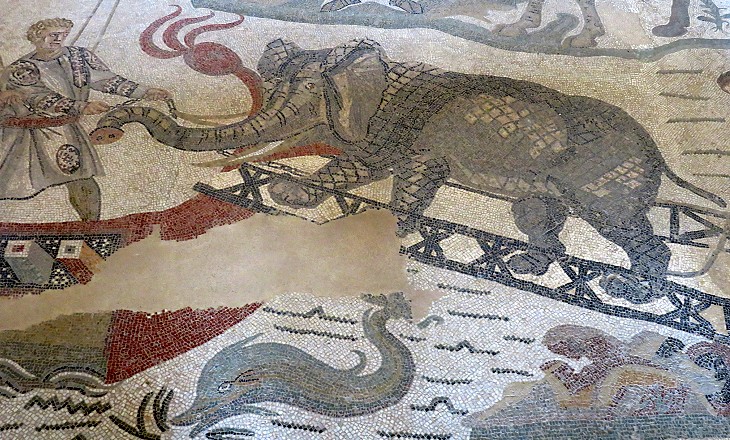
## Detail of a Roman mosaic in Villa del Casale
The First Punic War ended in 241 BC with the victory of the Romans. The Carthaginians were forced to abandon the island. In 212 BC, during the Second Punic War, Syracuse sided with the Carthaginians and it was sieged and seized by the Romans who completed their conquest of the island. Sicily became a Roman province of its own and it was never attached to other territories. It was a granary of the Empire: As for the fertility of the country, why should I speak of it, since it is on the lips of all men, who declare that it is no whit inferior to that of Italy? And in the matter of grain, honey, saffron, and certain other products, one might call it even superior. There is, furthermore, its propinquity; for the island is a part of Italy, as it were, and readily and without great labour supplies Rome with everything it has, as though from the fields of Italy. And in fact it is called the storehouse of Rome. Strabo - Geography - Book VI - Loeb Classical Library edition. In the late IIIrd century AD the owner of a latifundium, a vast estate, in the centre of the island decorated with mosaics all the floors of his large villa. These mosaics are the most interesting work of art of that period in Sicily and are evidence of the degree of wealth achieved by the owners of latifundia, similar to that of their colleagues in today's Tunisia.

## Akrai - Latomia dell'Intagliata: Byzantine catacomb
Sicily was not affected by the events which led to the decline of the Roman Empire until the end of the IVth century. During the Vth century it was raided and eventually conquered by the Vandals; later on it was ceded to the Italian Kingdom of the Ostrogoths. In 535 Belisarius, a general of Byzantine Emperor Justinian, landed on Sicily and easily took control of the island. The following centuries were a period of decline for Sicily, especially after the Arab conquest of northern Africa in the VIIth century. There are records suggesting that many large and richly decorated churches were built in Syracuse, but they were all destroyed by the Arabs in 878. Chronicles of the time and some evidence found by archaeologists indicate that the island was very impoverished and torn apart by conflicts among Byzantine officers. Although some of the finest mosaics which decorate Palermo and other towns are usually referred to as Byzantine, they were made in the XIIth century and Sicily retains very limited evidence of the direct Byzantine rule.
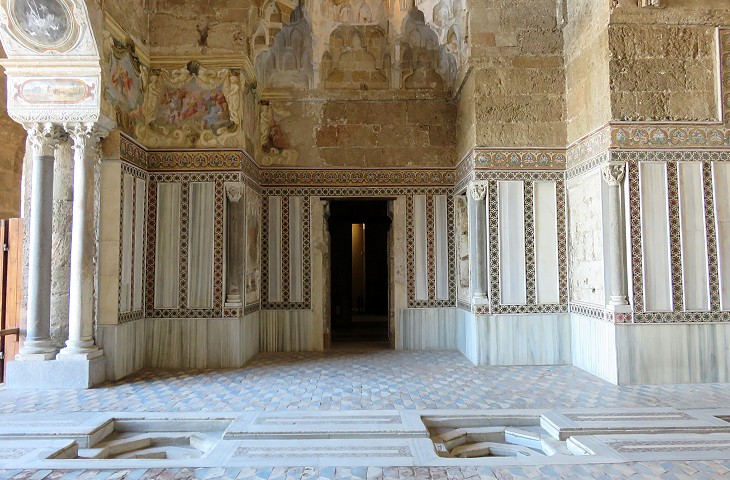
## Palermo - Zisa: main hall
In 828 a rift among Byzantine officers favoured the landing of an Arab army. The invaders conquered the western part of the island and established their capital at Palermo. The conquest of the whole island was very slow and it did not bring masses of Muslims to Sicily. Taormina, the last Byzantine stronghold fell in 902 and even after this event some inland parts of north-eastern Sicily were not occupied by the Arabs. The penetration of the new religion was relatively limited, although it is said that Palermo had 300 mosques. Arab travellers of the Xth century wrote enthusiastic descriptions of Palermo, but the main remaining evidence of the Arab rule is the maze of cul-de-sacs which characterizes some parts of the historical town and in particular its marketplaces. The examples of Islamic art which can be seen in Palermo are due to Arab architects and decorators who were employed by the Norman kings of Sicily in the design of churches and palaces in the XIIth century.
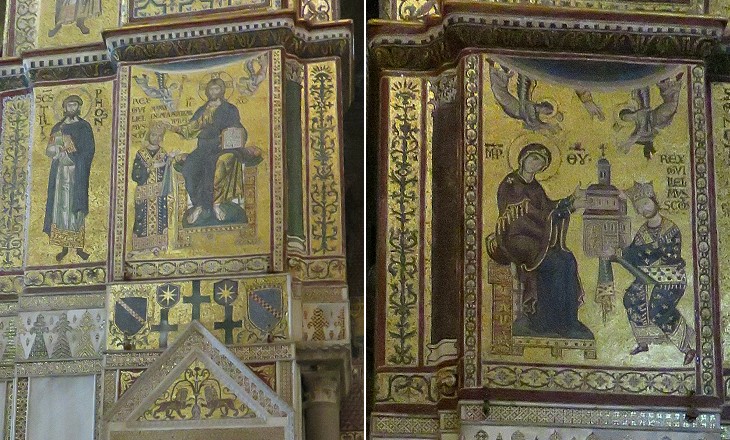
## Cathedral of Monreale: mosaics portraying King William II
In 1061 a rift among the emirs who ruled Sicily favoured the conquest of Messina by Roger d'Hauteville, brother of Robert the Guiscard, a Norman knight who had managed to become the de-facto ruler of most of southern Italy. The Normans with the support of the fleet of Pisa and the endorsement of the Pope conquered Palermo and were accepted by the Muslim population because they allowed them to retain their judicial system. In 1091 Roger landed on Malta which became a county of the Kingdom of Sicily until 1530. The island was repopulated with settlers coming from all parts of Italy and Europe. During the reign of King Roger II Sicily became a prosperous country. In 1148 he launched a campaign which led to the temporary conquest of Mahdia, Sousse, Monastir and Sfax on the coast of Tunisia. His grandson William II pursued a policy of tolerance towards his Muslim subjects, but after his death in 1189 they were persecuted by his successors.
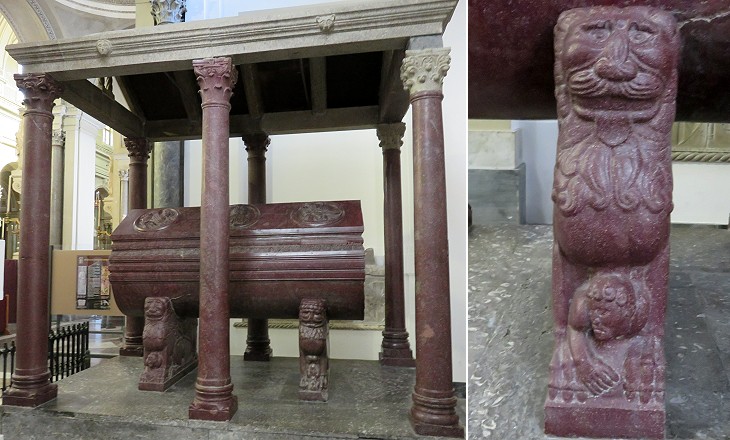
## Sarcophagus of Emperor Frederick II in the Cathedral of Palermo
King William II did not have direct successors and he left his kingdom to his aunt Costanza, wife of Roman Holy Emperor Henry VI. The union of the two crowns was opposed by Pope Clement III, but eventually Henry VI and later on Frederick II, his son, managed to be crowned Kings of Sicily (which included southern Italy). Frederick II often lived in Palermo and his interest in Italian affairs prevailed over that in German matters. During his long reign he was almost always in conflict with the Popes and was excommunicated four times. He took a hard stance towards the Muslims of Sicily; those who did not convert were relocated to Lucera in southern Italy. The Popes managed to detach Sicily from the Holy Roman Empire by offering its crown to Charles of Anjou, brother of King Louis IX of France. In 1266 Charles defeated Manfredi, illegitimate son of Frederick II, at Benevento. He set his court in Naples and this was resented by the Sicilian nobility. In 1282 a revolt in Palermo led to the massacre of the French garrison and was followed by revolts in other parts of the island. The rebels offered the crown of Sicily to Peter III, King of Aragon, husband of a daughter of Manfredi.
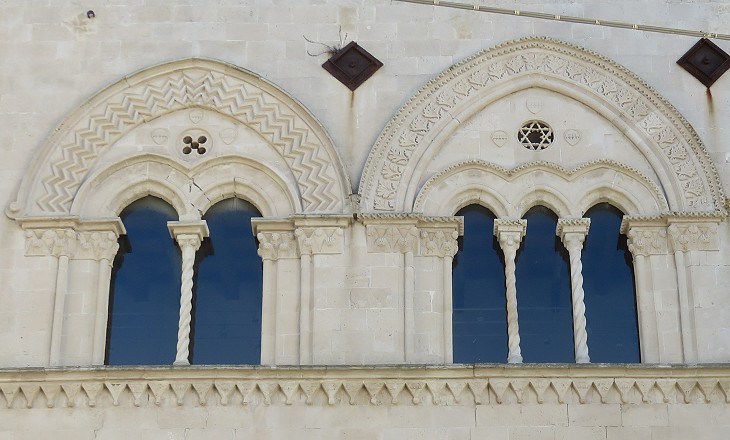
## Syracuse - Palazzo Mergulese Montalto (built in 1397)
Charles of Anjou and his successors did not give up their rights on Sicily and continued to call themselves Kings of Sicily. In 1302 a treaty established that the Angevins would retain the title of Kings of Sicily for their territories in southern Italy and the Aragonese would use the title of Kings of Trinacria for Sicily, but the agreement did not have lasting effects. For a long time the island was ruled by a branch of the Aragonese royal family. In the early XVth a marriage unified the two branches and the island was ruled by a viceroy, who was very often a Sicilian nobleman. The Aragonese introduced some elements of architecture (e.g. thin pointed arches) which were typical of buildings of their kingdom and more specifically of Catalonia, the region surrounding Barcelona.

## Palermo - Quattro Canti: (left to right) Holy Roman Emperor Charles V (Charles I, King of Sicily) and Philip II, III and IV, Kings of Spain and Sicily
The marriage of King Ferdinand II of Aragon and Queen Isabella I of Castile led to a personal union of their kingdoms in 1479. Their grandson Charles inherited from his father's side the title of Archduke of Austria and many territories in Central Europe. In 1516 he became King of Sicily and in 1519 he was elected Holy Roman Emperor. During his long reign he often fought against the Ottomans. In 1530 he assigned Malta to the Knights of Rhodes to strengthen its defence. After the conquest of Tunis in 1535 he spent some months in Sicily before going to Rome to celebrate a sort of triumphal procession in Piazza del Campidoglio. He promoted the construction of imposing fortifications in many Sicilian towns to protect them from Ottoman corsair raids. In 1556 he abdicated and he assigned the crown of Sicily to his son Philip II. Although Charles and his successors were also Kings of Naples they appointed separate viceroys for southern Italy and Sicily. From an artistic point of view, notwithstanding the political bonds with Spain, Sicily was open to the influence of Italian Renaissance and Baroque styles. The second half of the XVIIth century was un unlucky period for the island. In 1669 a major lava eruption from Mount Etna devastated the countryside north of Catania and eventually destroyed parts of the town and its harbour. In 1674 Messina rebelled to the Spanish rule and sought the help of King Louis XIV of France. A French fleet carrying troops reached the town and the Spaniards were unable to regain control of Messina until 1678. When eventually they succeeded the town was severely punished and it entered a long period of decline. In 1693 a major earthquake struck the south-eastern part of the island. Noto and other towns were razed to the ground, but also Syracuse and Catania experienced major damage.

## Relief in the southern entrance of the Cathedral of Palermo depicting Victor Amadeus II, Duke of Savoy being crowned King of Sicily in December 1713
[King Charles II of Spain](Storia26.html#Clement XI) died heirless in 1700. He left his possessions to a distant relative, Philip, Duke of Anjou who was a grandson of King Louis XIV of France. His will was not accepted by the Austrian branch of the Habsburg family and in 1702 a war broke out which affected many European countries (Spanish Succession War). Victor Amadeus II dared to side against his powerful French neighbour and his territories were invaded. In 1706 Turin, the capital of his Duchy, was sieged by the French but eventually Prince Eugene of Savoy, Amadeus' cousin, and commander of the Austrian army came to his aid. In 1713 the Treaties of Utrecht which brought the conflict to an end assigned the crown of Sicily to Amadeus. In 1718 Philip of Anjou, now King Philip V of Spain made an attempt to reconquer Sicily. A Spanish army landed on the island and easily gained control of its main towns, but the Spanish fleet suffered a great defeat by the British one at Capo Passero and the troops in Sicily could not receive reinforcements and supplies from their country. An Austrian army occupied Messina and eventually the whole island. In 1720 Amadeus was forced to exchange Sicily with Sardinia, a less important island and Holy Roman Emperor Charles VI became King of Sicily.
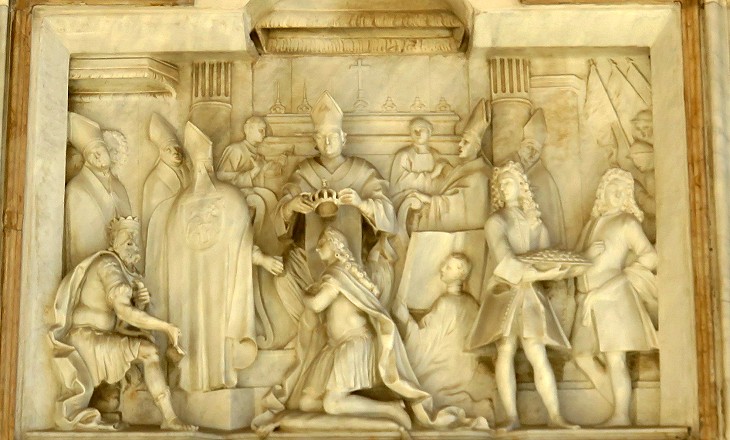
## Relief in the Cathedral of Palermo depicting Charles of Bourbon being crowned Charles III, King of Sicily in 1735 (a personification of Palermo can be seen in the lower left corner of both reliefs)
The Sicilian nobility was very hostile to the Austrian rule; during the long Aragonese/Spanish rule Sicilian noble families enjoyed privileges which Emperor Charles VI was reluctant to grant. In 1733 a new Succession War broke out in Europe; it was related to the Kingdom of Poland, but it was actually an attempt by France and Spain to regain some of the territories/influence they had lost in the previous Succession War. Charles of Bourbon, a cadet son of King Philip V of Spain, managed to defeat the Austrians and conquer Naples where he received delegates of the Sicilian nobility who offered him the crown of Sicily. Although in 1759 he succeeded his half-brother as King of Spain, the Kingdoms of Naples and of Sicily did not become Spanish possessions and were ruled by a local dynasty because Charles placed his cadet son Ferdinand on their thrones. In 1816 Ferdinand formally unified the two kingdoms into the Kingdom of the Two Sicilies. In 1817 he formally decreed that Naples was the only capital of the Kingdom, thus alienating the sympathies of the Sicilians from him and his successors.
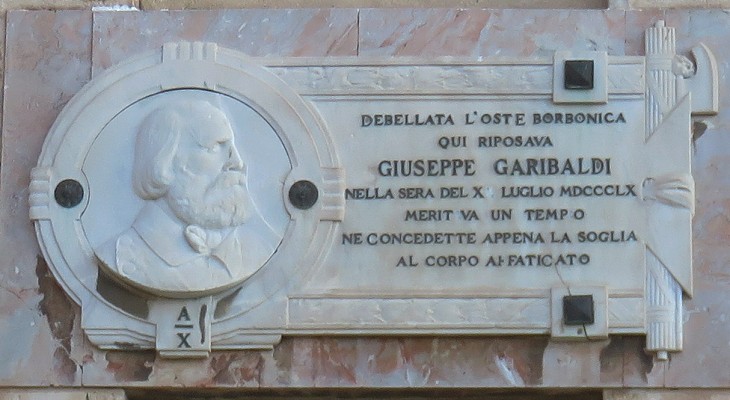
## Plaque at Milazzo celebrating the victory by [Giuseppe Garibaldi](Storia29.html#Red Shirts) in July 1860
In 1848 a revolt broke out at Palermo which the troops loyal to King Ferdinand II were unable to quell. It soon spread to other parts of the island. Its objective was the creation of a constitutional Kingdom of Sicily. Initially the King made promises which met some of the rebels' demands, but when the general European revolutionary movement lost impetus, he did not hesitate to cannon Messina and threaten to do the same in Palermo to impose his rule. Eventually many members of influential Sicilian families went into exile. Some of them were welcomed in Turin, capital of the Kingdom of Sardinia, where Prime Minister Camillo Benso di Cavour was developing a plan of political alliances which eventually led to the unification of Italy. On May 11, 1860 Garibaldi and his Red Shirts landed at Marsala and by the end of July the troops of the King of the Two Sicilies surrendered in the whole island. In October a referendum declared that the Sicilians agreed on Victor Emmanuel II (King of Sardinia) becoming the constitutional King of Italy.